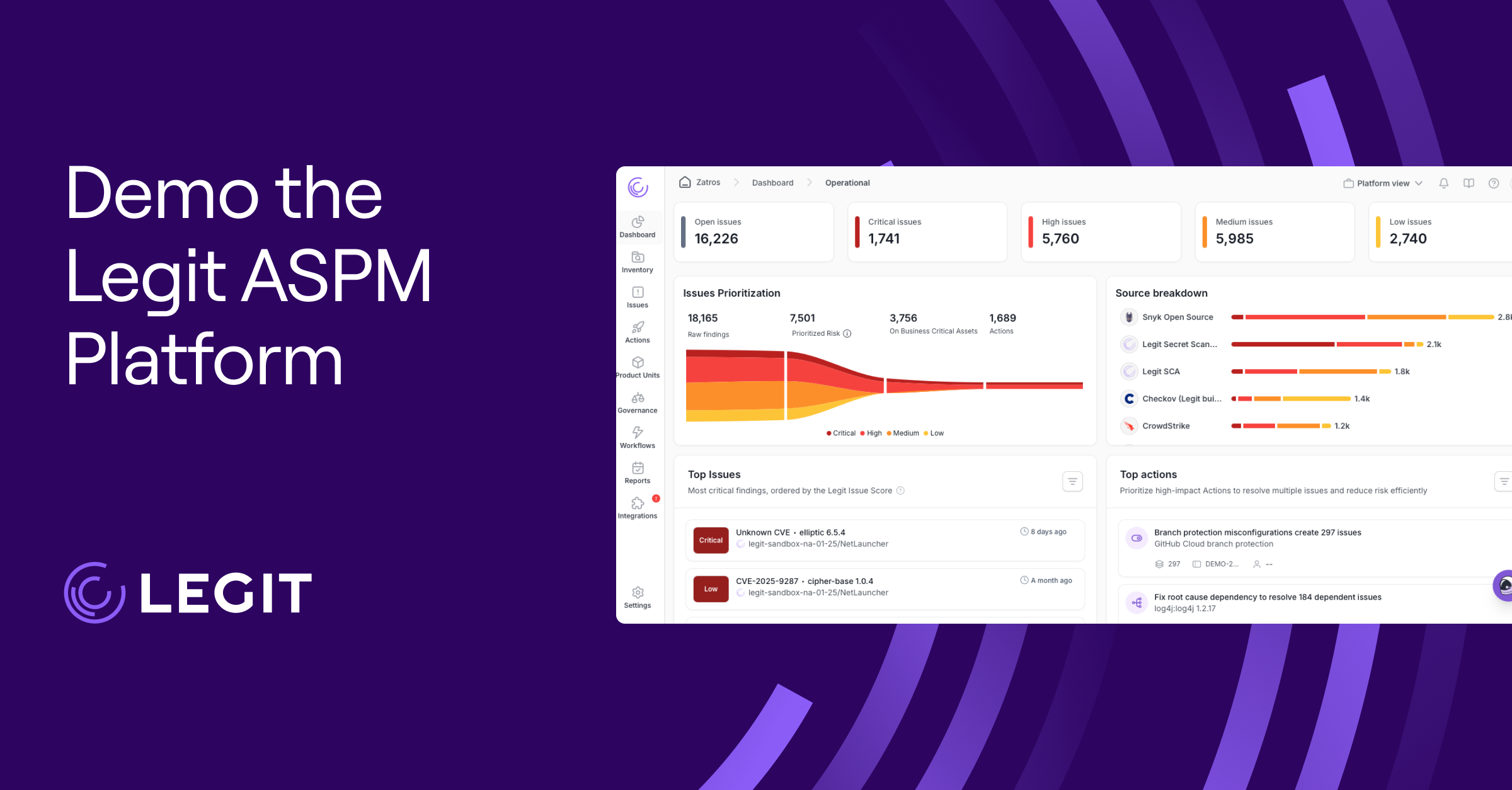Software supply chain attacks have exploded in recent years, and open-source ecosystems often sit at the center of the storm. Attackers target public repositories like GitHub’s npm and the Python Package Index (PyPI) to slip malicious code into widely used packages, then count on developers pulling those updates into production without noticing.
This article explains what open-source malware is, how cybercriminals exploit open-source projects, and the most common types you might encounter. Once you know the biggest risks, build your malware detection and protection with four techniques—and Legit Security’s support.
What Is Open-Source Malware?
Open-source malware is malicious code intentionally hidden in open-source packages that developers download from registries like npm or PyPI. Unlike vulnerabilities that need exploits, malware is designed to be harmful the moment it runs. That makes open-source malware harder to ignore and quicker to cause damage.
Attackers sneak this malware into dependencies so it executes during installation, build, or runtime, often under the guise of a trusted library. Because applications depend on long chains of third-party code, one infected package can cascade across multiple projects almost instantly.
Security teams use open-source malware analysis to understand how these threats spread and open-source malware detection tools to catch malicious packages before they reach production. This approach gives organizations a fighting chance to keep malware out of their pipeline.
How Cybercriminals Exploit OSS
Attackers go after open-source software (OSS) because it gives them reach and efficiency. According to Harvard’s Laboratory for Innovation Science and the Linux Foundation’s joint Census II research, free and open-source components make up 70% to 90% of any given application. Compromising a single package can ripple through thousands of projects downstream.
That broad footprint turns public repositories like GitHub and package managers into high-value targets: Compromise one widely used library, and you get access to a massive surface. Recent examples, like the September 2025 Shai-Hulud worm that compromised npm packages, demonstrate how quickly these attacks can spread.
The techniques cybercriminals use run from blunt to highly engineered:
- Typosquatting/name-squatting: Attackers publish packages with names that mimic popular libraries; a mistyped install can pull the malicious package instead.
- Dependency confusion: Cybercriminals release a public package using the same name as a private package, so automated builds pull the attacker’s package.
- Version seeding: Hackers push a malicious release with a higher semantic version or favored tag, so dependency managers that default to the latest release and continuous integration and continuous delivery (CI/CD) pipelines pull the seeded package.
- Account and CI compromise: Attackers steal a maintainer or compromise GitHub accounts and push malicious updates posing as a trusted identity.
Threat actors aren’t only opportunists. Advanced Persistent Threat (APT) groups and state-sponsored campaigns invest time and resources to gain persistent access, using social engineering, staged contributions, and account takeovers to smuggle backdoors or data exfiltration tools into trusted libraries.
That’s why open-source software risks should map to business risks: These attacks can quickly become costly operational outages if malicious code reaches production.
5 Types of Open-Source Malware
Open-source packages are convenient, but they can deliver fully fledged malware directly into your app or CI pipeline. The list below names five of the most common payloads attackers slip into libraries, how they behave in an OSS supply chain, and signs one has entered your network.
1. Botnets
Compromised packages can install lightweight agents that enroll hundreds or thousands of hosts into a botnet. This network of automated bots gives attackers a distributed fleet for DDoS or spam, allowing them to coordinate simultaneous attacks across multiple infected systems. In the context of OSS, a single tainted dependency can seed the same agent across projects and multiply the impact fast. Monitor for unusual outbound connections from build and runtime environments and investigate packages that call home to unknown domains.
2. Keyloggers and Infostealers
Malicious libraries can capture keystrokes or steal credential files and API keys from development and runtime machines. These infostealers often hide inside transitive dependencies and CI scripts, so only scanning direct dependencies won’t catch them. Treat any package that accesses standard input, environment variables, or local secrets as high risk until verified.
3. Remote Access Trojans (RATs)
A RAT gives an attacker persistent remote control over an infected host. Attackers sometimes plant these backdoors in a library's install script or a build step, so the payload triggers as soon as an app runs or a container starts. Because these backdoors can look like legitimate maintenance procedures, use a combination of behavioral detection and provenance checks to spot them.
4. Rootkits
Rootkits aim to hide malware and keep data around after closing the program by modifying system or container internals. When attackers slip these capabilities in, removing the package doesn’t always uproot the implant. Watch for packages that modify file permissions or run low-level kernel or container commands during installation or runtime.
5. Cryptojackers
Some malicious packages silently mine cryptocurrency by running heavy workloads that drain CPU, memory, or cloud credits. These payloads reduce performance and inflate costs—often without obvious signs. Track sudden spikes in resource use, and put a red flag on packages that spawn long-running processes or attach to GPU/CPU-intensive libraries.
Open-Source Malware Protection and Detection Methods
Effective malware detection requires carefully navigating multiple security layers and detection methods. Block risky packages at the source, run layered scans during build and runtime, and keep a tested open-source malware removal playbook ready if something does get through.
Here are a few techniques and tools you can add to bolster OSS protection.
Integrate SCA, SAST, and DAST Into the SDLC
Scan for known malicious packages and suspicious code at multiple stages of the SDLC. Software composition analysis (SCA) maps transitive dependencies and flags typosquats, static application security testing (SAST) finds unsafe code patterns before merge, and dynamic application security testing (DAST) exercises running apps to reveal malicious behavior that static tools might miss.
By regularly testing with these tools, you’re more likely to catch problems before they cause major incidents. Use all three together to build a strong foundation of open-source malware protection.
Implement Continuous Scanning
Put an artifact repository or firewall between public registries and your builds, scan registries and your internal cache in real time, and quarantine or block suspicious packages before developers can pull them into CI.
Conduct Behavioral Analysis
Combine runtime telemetry and alerts so you can spot implants that static scans miss. Runtime observability closes gaps in your malware protection posture by catching behavior-based attacks that skip past signature checks, like unusual install-time actions or unexpected network callbacks.
Harden Provenance
When the whole team is accountable for their actions, it’s easier to trace where malware may have snuck in. One way to do this is to require signed, immutable artifacts, two-factor authentication, and commit signing for maintenance accounts. Pin dependency versions and rotate pipeline secrets to cut off any access, and block any install-time scripts that haven’t been reviewed.
When an incident does happen, follow your malware removal playbook immediately: Isolate the infected build, then revoke credentials, rotate keys, and extract tainted artifacts from caches and registries.
Risks From Open-Source Malware
Open-source malware has grown from a sporadic nuisance into a volume problem. Sonatype’s 2024 Open-Source Malware Report observed roughly 778,500 malicious packages since 2019 and a 156% increase in malware from 2023, with shadow downloads (direct pulls that bypass repo controls) in particular up by about 32%. That surge combines typosquats, repackaging, and potentially unwanted artifacts with tactics that hijack maintainers or CI pipelines.
A single tainted package can break builds or leak secrets and intellectual property, triggering costly incident response and compliance headaches across many products downstream. And while malware can show up anywhere, activity tends to concentrate in a few ecosystems, with JavaScript-based npm showing particularly high malicious-package activity and fast download growth.
Some of the biggest problems from not catching open-source malware include:
- Operational outages: A tainted dependency can break builds or production systems at scale.
- Secret leakage: Malicious code can pull API keys, .env values, and proprietary information to share or sell.
- Broad downstream impact: One compromised package can affect everyone, including customers and third-party vendors, and harm a wide range of systems.
- Persistent intrusion: Attackers have used social engineering and staged contributions to gain maintainers' trust and push backdoors into widely used libraries.
- Resource abuse: Cryptojackers or hidden workloads can inflate cloud bills and degrade system performance.
- Regulatory fallout: Compromised components can trigger compliance violations or vendor liability.
Protect Against Open-Source Malware With Legit Security
Protect your software supply chain by preventing malicious packages from ever reaching builds. Legit Security gives you a strong SDLC-wide security posture. It continuously scans repos and registries, and enforces artifact and dependency controls so risky components get blocked before they hit the CI.
When something slips through, Legit surfaces real-time telemetry and context—who pulled the package, which builds and environments used it, and what secrets or artifacts that package touches—so you can quickly revoke and remove tainted artifacts.
Legit’s secrets scanning and enforcement controls let you automate containment and follow a clear, open-source malware removal playbook, shortening the time to detection and remediation without slowing development.
Request a demo to try Legit Security’s monitoring and scanning tools for your OSS.
Download our new whitepaper.


